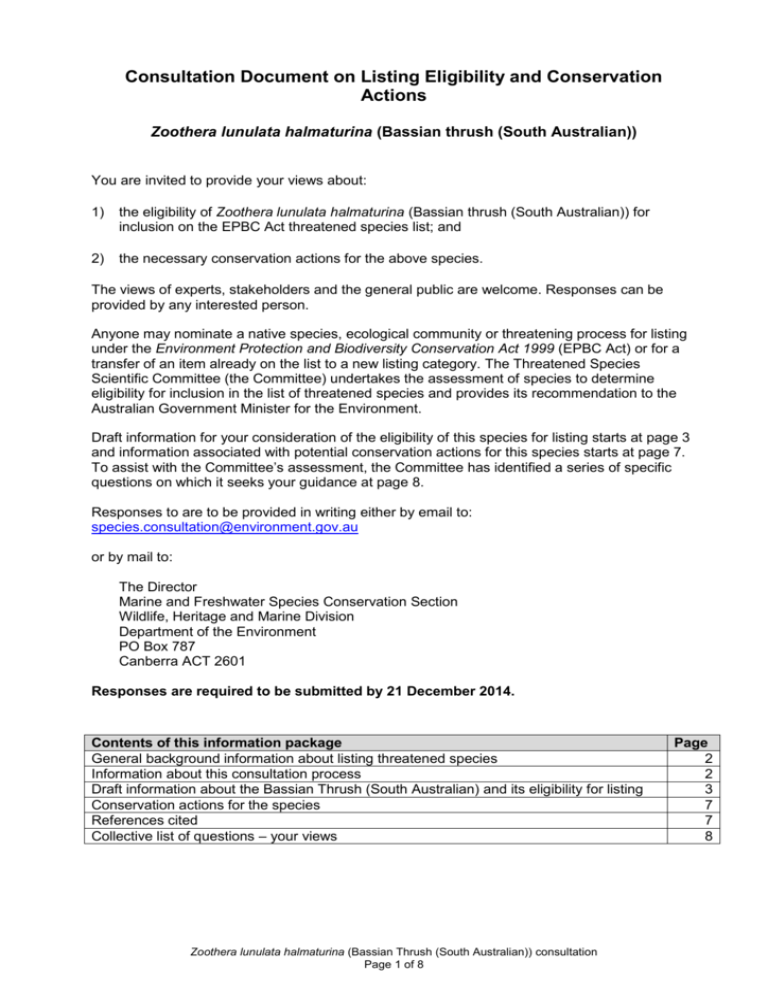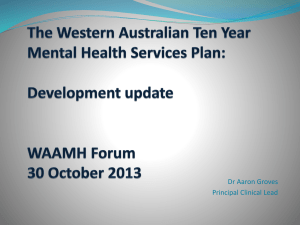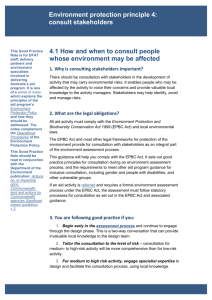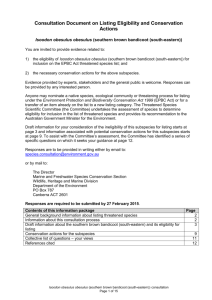(Bassian thrush (South Australian))
advertisement

Consultation Document on Listing Eligibility and Conservation Actions Zoothera lunulata halmaturina (Bassian thrush (South Australian)) You are invited to provide your views about: 1) the eligibility of Zoothera lunulata halmaturina (Bassian thrush (South Australian)) for inclusion on the EPBC Act threatened species list; and 2) the necessary conservation actions for the above species. The views of experts, stakeholders and the general public are welcome. Responses can be provided by any interested person. Anyone may nominate a native species, ecological community or threatening process for listing under the Environment Protection and Biodiversity Conservation Act 1999 (EPBC Act) or for a transfer of an item already on the list to a new listing category. The Threatened Species Scientific Committee (the Committee) undertakes the assessment of species to determine eligibility for inclusion in the list of threatened species and provides its recommendation to the Australian Government Minister for the Environment. Draft information for your consideration of the eligibility of this species for listing starts at page 3 and information associated with potential conservation actions for this species starts at page 7. To assist with the Committee’s assessment, the Committee has identified a series of specific questions on which it seeks your guidance at page 8. Responses to are to be provided in writing either by email to: species.consultation@environment.gov.au or by mail to: The Director Marine and Freshwater Species Conservation Section Wildlife, Heritage and Marine Division Department of the Environment PO Box 787 Canberra ACT 2601 Responses are required to be submitted by 21 December 2014. Contents of this information package General background information about listing threatened species Information about this consultation process Draft information about the Bassian Thrush (South Australian) and its eligibility for listing Conservation actions for the species References cited Collective list of questions – your views Zoothera lunulata halmaturina (Bassian Thrush (South Australian)) consultation Page 1 of 8 Page 2 2 3 7 7 8 General background information about listing threatened species The Australian Government helps protect species at risk of extinction by listing them as threatened under Part 13 of the EPBC Act. Once listed under the EPBC Act, the species becomes a Matter of National Environmental Significance (MNES) and must be protected from significant impacts through the assessment and approval provisions of the EPBC Act. More information about threatened species is available on the department’s website at: http://www.environment.gov.au/biodiversity/threatened/index.html. Public nominations to list threatened species under the EPBC Act are received annually by the department. In order to determine if a species is eligible for listing as threatened under the EPBC Act, the Threatened Species Scientific Committee (the Committee) undertakes a rigorous scientific assessment of its status to determine if the species is eligible for listing against a set of criteria. These criteria are available on the Department’s website at: http://www.environment.gov.au/biodiversity/threatened/pubs/guidelines-species.pdf. As part of the assessment process, the Committee consults with the public and stakeholders to obtain specific details about the species, as well as advice on what conservation actions might be appropriate. Information provided through the consultation process is considered by the Committee in its assessment. The Committee provides its advice on the assessment (together with comments received) to the Minister regarding the eligibility of the species for listing under a particular category and what conservation actions might be appropriate. The Minister decides to add, or not to add, the species to the list of threatened species under the EPBC Act. More detailed information about the listing process is at: http://www.environment.gov.au/biodiversity/threatened/nominations.html. To promote the recovery of listed threatened species and ecological communities, conservation advices and where required, recovery plans are made or adopted in accordance with Part 13 of the EPBC Act. Conservation advices provide guidance at the time of listing on known threats and priority recovery actions that can be undertaken at a local and regional level. Recovery plans describe key threats and identify specific recovery actions that can be undertaken to enable recovery activities to occur within a planned and logical national framework. Information about recovery plans is available on the department’s website at: http://www.environment.gov.au/biodiversity/threatened/recovery.html. Information about this consultation process Responses to this consultation can be provided electronically or in hard copy to the contact addresses provided on Page 1. All responses received will be provided in full to the Committee and then to the Australian Government Minister for the Environment. In providing comments, please provide references to published data where possible. Should the Committee use the information you provide in formulating its advice, the information will be attributed to you and referenced as a ‘personal communication’ unless you provide references or otherwise attribute this information (please specify if your organisation requires that this information is attributed to your organisation instead of yourself). The final advice by the Committee will be published on the department’s website following the listing decision by the Minister. Information provided through consultation may be subject to freedom of information legislation and court processes. It is also important to note that under the EPBC Act, the deliberations and recommendations of the Committee are confidential until the Minister has made a final decision on the nomination, unless otherwise determined by the Minister. Zoothera lunulata halmaturina (Bassian Thrush (South Australian)) consultation Page 2 of 8 Zoothera lunulata halmaturina Bassian thrush (South Australian) Taxonomy Generally accepted as Zoothera lunulata halmaturina (Bassian thrush (South Australian)), A.G. Campbell, 1906. It is one of three subspecies of Bassian thrush, which is endemic to Australia. Description The Bassian thrush is olive-brown to golden brown above, and whitish below. It has mottled plumage, with scalloped black crescent-shaped bars on its back, rump and head and brownblack scalloping on its underparts. It has a large straight bill with a hooked tip, and a narrow white eye-ring. In flight a broad dark diagonal bar across the white underside of its wing can be seen. It is very similar to the Russet-tailed thrush Zoothera heinei but is slightly larger with a slightly longer tail. Distribution The Bassian thrush (South Australian) occurs on Kangaroo Island, the Mt Lofty Ranges as far north as Tarunda, and in the southern Flinders Ranges from Wirrabara Forest reserve and Telowie Gorge Conservation Park to Mt Remarkable National Park. Movements of other subspecies suggest that the mainland and Kangaroo Island birds are likely to constitute a single subpopulation. It is confined to remnant habitats on the mainland but is widespread on Kangaroo Island. Relevant Biology/Ecology The subspecies mostly inhabits damp eucalypt forest or woodland. Densely forested areas and gullies are favoured, usually with a thick canopy overhead, a thick understorey of small trees and tall shrubs, and leaf-litter below. However, it has also been recorded breeding in exotic Monterey Pine Pinus radiata plantations, and on Kangaroo Island also uses mature mallee eucalypt woodland. In much of its range, suitable habitat is confined to creek lines or dune swales. Damp habitats seem particularly important in summer (Garnett et al., 2011; Department for Environment and Heritage, 2008). It is mostly sedentary, although there is some evidence for seasonal movements especially altitudinally. It is shy and secretive with a low flight, its mottled pattern also making it inconspicuous in leaf-litter. Its diet consists of invertebrates, mainly earthworms and beetles, and occasionally fruit. It mainly forages on the ground by probing leaf litter, but sometimes takes fruit from low shrubs. It forages singly, or in small groups (possibly family groups) of two to five. It is probably territorial (Higgins et al., 2006; Department for Environment and Heritage, 2008). Breeding occurs from May to November, with 2-3 eggs laid once a year. A large, bowl-shaped nest is usually placed in a fork of a tree, or occasionally on a thick horizontal branch. Nest sites are hidden among dense foliage, and may be quite low or up to 15 m above the ground. The young are altricial and nidicolous, and fed by both sexes (Higgins et al., 2006). The generation time is estimated at 5.2 years (Garnett et al., 2011; Department for Environment and Heritage, 2008). Threats Threats differ between the mainland and Kangaroo Island. On the mainland, much of the best habitat has been cleared for agriculture in the past. Currently, inappropriate fire regimes are the major threat and can make habitat unsuitable for the subspecies. Other threats include the damming of creeks, which results in the desiccation of the litter layer downstream; weed invasion; grazing by cattle (Bos primigenius), rabbits (Oryctolagus cuniculus) and kangaroos (Macropus sp.); competition with the introduced common blackbird (Turdus merula); and Zoothera lunulata halmaturina (Bassian Thrush (South Australian)) consultation Page 3 of 8 predation by foxes (Vulpes vulpes) and feral and uncontrolled domestic cats (Felis catus) (Garnett et al., 2011). On Kangaroo Island much of the decline in the last decade can be attributed to below-average rainfall. It is unknown whether sites that dried out entirely will be re-occupied. Feral cats (Felis catus) and inflated populations of the common brushtail possum (Trichosurus vulpecular) on the island are also likely to take some adults and nestlings. Much habitat has been cleared but gullies are often undisturbed and rarely burnt (Garnett et al., 2011). How judged by the Committee in relation to the EPBC Act Criteria and Regulations Criterion 1: Reduction in numbers (based on any of A1 – A4) A1. An observed, estimated, inferred or suspected population very severe 90%, severe 70% or substantial 50% size reduction over the last 10 years or three generations, whichever is the longer, where the causes of the reduction are clearly reversible AND understood AND ceased, based on (and specifying) any of the following: (a) direct observation (b) an index of abundance appropriate to the taxon (c) a decline in area of occupancy, extent of occurrence and/or quality of habitat (d) actual or potential levels of exploitation (e) the effects of introduced taxa, hybridization, pathogens, pollutants, competitors or parasites. A2. An observed, estimated, inferred or suspected population very severe 80%, severe 50% or substantial 30% size reduction over the last 10 years or three generations, whichever is the longer, where the reduction or its causes may not have ceased OR may not be understood OR may not be reversible, based on (and specifying) any of (a) to (e) under A1. A3. A population size reduction very severe 80%, severe 50% or substantial 30%, projected or suspected to be met within the next 10 years or three generations (up to a maximum of 100 years), whichever is the longer, based on (and specifying) any of (b) to (e) under A1. A4. An observed, estimated, inferred, projected or suspected population size reduction very severe 80%, severe 50% or substantial 30% over any 10 year or three generation period (up to a maximum of 100 years into the future), whichever is longer, where the time period must include both the past and the future, and where the reduction or its causes may not have ceased OR may not be understood OR may not be reversible, based on (and specifying) any of (a) to (e) under A1. Evidence As at 2010, the population is estimated to be 4200 mature individuals and declining (Garnett et al., 2011). There are probably about 4000 mature individuals on Kangaroo Island. Anecdotal reports suggest a decline in calls heard on Kangaroo Island in the last decade, but no other reports of decline. The subspecies is very rare in the Mt Lofty Ranges, where there are probably < 100 birds and where it is thought to have declined by 30%. There may also be about 100 birds in the southern Flinders Ranges, based on the area of suitable habitat (Garnett et al., 2011). The information presented above appears to demonstrate that the subspecies is not eligible for listing under this criterion. However, the purpose of this consultation draft advice is to elicit additional information to better understand the subspecies status. This conclusion should therefore be considered tentative at this stage, as it may change as a result of responses to this consultation process. Criterion 2: Geographic distribution (based on either of B1 or B2) B1. Extent of occurrence estimated to be very restricted <100 km2, restricted <5000 km2 or limited <20 000 km2 Zoothera lunulata halmaturina (Bassian Thrush (South Australian)) consultation Page 4 of 8 B2. Area of occupancy estimated to be very restricted <10 km2, restricted <500 km2 or limited <2000 km2 AND Geographic distribution is precarious for the survival of the species, (based on at least two of a–c) a. Severely fragmented or known to exist at a limited location. b. Continuing decline, observed, inferred or projected, in any of the following: (i) extent of occurrence (ii) area of occupancy (iii) area, extent and/or quality of habitat (iv) number of locations or subpopulations (v) number of mature individuals. c. Extreme fluctuations in any of the following: (i) extent of occurrence (ii) area of occupancy (iii) number of locations or subpopulations (iv) number of mature individuals. Evidence As at 2010, the extent of occurrence is estimated to be 7900 km2 and the area of occupancy estimated to be 1000 km2 (Garnett et al., 2011). The subspecies exists at more than 10 locations and is not considered limited. The population appears to be declining, but has not exhibited extreme fluctuations (Garnett et al., 2011). The information presented above appears to demonstrate that the subspecies is not eligible for listing under this criterion, as although the extent of occurrence and area of occupancy are limited, the population does not exist at a limited location, is not severely fragmented, and has not exhibited extreme fluctuations. However, the purpose of this consultation draft advice is to elicit additional information to better understand the subspecies status. This conclusion should therefore be considered tentative at this stage, as it may change as a result of responses to this consultation process. Criterion 3: The estimated total number of mature individuals is very low <250, low <2500 or limited <10 000; and either of (A) or (B) is true (A) evidence suggests that the number will continue to decline at a very high (25% in 3 years or 1 generation (up to 100 years), whichever is longer), high (20% in 5 years or 2 generations (up to 100 years), whichever is longer) or substantial (10% in 10 years or 3 generations (up to 100), whichever is longer) rate; or (B) the number is likely to continue to decline and its geographic distribution is precarious for its survival (based on at least two of a – c): a. Severely fragmented or known to exist at a limited location. b. Continuing decline, observed, inferred or projected, in any of the following: (i) extent of occurrence (ii) area of occupancy (iii) area, extent and/or quality of habitat (iv) number of locations or subpopulations (v) number of mature individuals. c. Extreme fluctuations in any of the following: (i) extent of occurrence (ii) area of occupancy (iii) number of locations or subpopulations (iv) number of mature individuals. Zoothera lunulata halmaturina (Bassian Thrush (South Australian)) consultation Page 5 of 8 Evidence As at 2010, the total number of individuals is estimated at 4200 (Garnett et al., 2011) and there is an inferred ongoing decline in numbers. However, there is no evidence to suggest that the number will continue to decline at a substantial or higher rate, or that the geographic distribution is precarious for survival (Garnett et al., 2011). The information presented above appears to demonstrate that the subspecies is not eligible for listing under this criterion, as although the total number of individuals is limited and declining, there is no evidence to suggest that the number will continue to decline at a substantial or higher rate or that its geographic distribution is precarious for its survival. However, the purpose of this consultation draft advice is to elicit additional information to better understand the subspecies status. This conclusion should therefore be considered tentative at this stage, as it may change as a result of responses to this consultation process. Criterion 4: Estimated total number of mature individuals: (a) Extremely low <50 (b) Very low <250 (c) Low <1000 Evidence As at 2010, the total number of individuals is estimated at 4200 (Garnett et al., 2011). The data presented above appear to demonstrate that the subspecies is not eligible for listing under this criterion, as the number of mature individuals is low. However, the purpose of this consultation draft advice is to elicit additional information to better understand the subspecies status. This conclusion should therefore be considered tentative at this stage, as it may change as a result of responses to this consultation process. Criterion 5: Probability of extinction in the wild based on quantitative analysis is at least: (a) 50% in the immediate future, 10 years or three generations (whichever is longer); or (b) 20% in the near future, 20 years or five generations (whichever is longer); or (c) 10% in the medium-term future, within 100 years. Evidence Population viability analysis has not been undertaken for this species, therefore there is insufficient information to assess against this criterion. Recovery Plan There should not be a recovery plan for Zoothera lunuata halmaturina as conservation advice for the subspecies would provide sufficient direction to implement priority actions and mitigate against the key threats. Recovery and Impact avoidance guidance Primary Conservation Objectives 1. Populations retained in the Mt Lofty and southern Flinders Ranges. Important populations The single subpopulation is of high conservation value. Important habitat for the survival of the subspecies Zoothera lunulata halmaturina (Bassian Thrush (South Australian)) consultation Page 6 of 8 Damp eucalypt forest or woodland, and mature mallee eucalypt woodland on Kangaroo Island, are important habitat for this subspecies. Information required, research and monitoring priorities 1. Trends in numbers at Mt Lofty Ranges, southern Flinders Ranges, and Kangaroo Island 2. Monitor numbers on the mainland 3. Survey Kangaroo Island to determine density and abundance Management actions required 1. Maintain the subspecies’ habitat values in all mainland reserves. 2. Protect remnant habitats from wild fire. References cited in the advice Department for Environment and Heritage (2008). Adelaide and Mount Lofty Ranges South Australia Threatened Species Profile Zoothera lunulata halmaturina. Retrieved 8 July 2014 from www.environment.sa.gov.au/. Department for Environment and Heritage (2001). Biodiversity plan for Kangaroo Island, South Australia 2001. Retrieved 28 July 2014 from http://nrmonline.nrm.gov.au/catalog/mql:16 Department of Environment, Water and Natural Resources (2013). Biodiversity in the Flinders Ranges National Park – Discussion Paper. Retrieved 28 July 2014 from http://www.environment.sa.gov.au/haveyoursay/flindersranges-mgtplan. Garnett ST, Szabo JK and Dutson G (2011). The Action Plan for Australian Birds 2010. Birds Australia, CSIRO Publishing, Melbourne. Higgins PJ, Peter JM, Cowling SJ, eds. (2006) Handbook of Australian, New Zealand and Antarctic Birds. Volume 7 Boatbill to Starlings, Part B Dunnock to Starlings. Oxford University Press, Melbourne. Zoothera lunulata halmaturina (Bassian Thrush (South Australian)) consultation Page 7 of 8 Collective list of questions – your views 1. Do you agree with the current taxonomic position of the Australian Faunal Directory and Birdlife Australia for this species (as identified in the draft conservation advice) 2. Can you provide any additional references, information or estimates on longevity, age of maturity, average life span and generation length? 3. Has the survey effort for this species been adequate to determine its national distribution and adult population size? 4. Do you accept the estimate provided in the nomination for the current population size of the species? 5. For any population with which you are familiar, do you agree with the population estimate provided? If not, are you able to provide a plausible estimate based on your own knowledge? If so, please provide in the form: Lower bound (estimated minimum): Upper bound (estimated maximum): Best Estimate: Estimated level of Confidence: % 6. Can you provide any additional data, not contained in the current nomination, on declines in population numbers over the past or next 10 years or 3 generations, whichever is the longer? 7. Is the distribution as described in the nomination valid? Can you provide an estimate of the current geographic distribution (extent of occurrence or area of occupancy in km2) of this species? 8. Has this geographic distribution declined and if so by how much and over what period of time? 9. Do you agree that the species is eligible for inclusion on the threatened species list, in the category listed in the nomination? 10. Do you agree that the threats listed are correct and that their effects on the species are significant? 11. To what degree are the identified threats likely to impact on the species in the future? 12. Can you provide additional or alternative information on threats, past, current or potential that may adversely affect this species at any stage of its life cycle? 13. In seeking to facilitate the recovery of this species, can you provide management advice for the following: What individuals or organisations are currently, or need to be, involved in planning to abate threats and any other relevant planning issues? What threats are impacting on different populations, how variable are the threats and what is the relative importance of the different populations? What recovery actions are currently in place, and can you suggest other actions that would help recover the species? Please provide evidence and background information. 14. Can you provide additional data or information relevant to this assessment? 15. Can you advise as to whether this species is of cultural significance to Indigenous Australians? Zoothera lunulata halmaturina (Bassian Thrush (South Australian)) consultation Page 8 of 8





